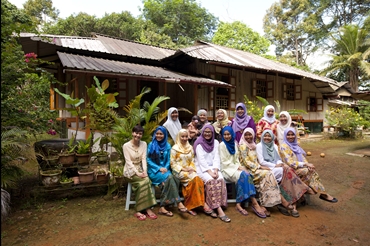Kampong Life
Ubin of Yesteryears
Pulau Ubin was formerly a cluster of 5 smaller islands separated by tidal rivers. Local Malays once called the island "Pulau Batu Jubin" or "Granite Stone island". This is because, in the old days, the granite from the island was quarried to make floor tiles or jubin in Malay. The name of the island was later shortened to Pulau Ubin.
In the 16th century, Ubin was part of the Johor-Riau Empire. The earliest inhabitants of the island were the Orang Laut (or “Sea People”) and indigenous Malays of Bugis and Javanese origins.
Click here to watch a 30-minute Chinese television feature by the Singapore Broadcasting Corporation (now MediaCorp) in 1990.
Golden Age of Granite Mining
By the mid-1800s, a sizable Chinese community moved to the island to work at the quarries. Pulau Ubin became a hotbed for granite quarrying. The granite was used for the construction of the Horsburgh Lighthouse on Pedra Branca completed in 1851, Fort Canning in 1858 and the Causeway in 1923. Many Kheks (Chinese dialect group) also settled on the central and western parts of the island, adding to the vast labour force which worked at the quarries.
Granite quarrying activities on Pulau Ubin peaked in the 1930s when private quarries operated on the island. Besides granite quarrying, the island was also opened up for commercial crop cultivation. Coffee, nutmeg, pineapple, coconut, durian, tobacco and rubber plantations were started at different times across the island.
Other activities included prawn farming, fishing and poultry rearing.
Rise of the Ubin Inhabitants
During the 1880s, around 50 Malay families from the Kallang River in mainland Singapore moved to Pulau Ubin to be fishermen. The movement of workers and settlers from Singapore added to the population of Pulau Ubin. It led to the proliferation of kampongs on the island. Kampongs were established near the northern coast at Kampong Noordin, Kampong Bahru, Kampong Mamam and Kampong Petai, while Kampong Chek Jawa developed in the eastern side of the island.
Pulau Ubin's "Kepala"
As the population grew larger, the original inhabitants and the new settlers to Pulau Ubin soon had to deal with the issue of maintaining social order on the island. The original inhabitants resented the arrival of more and more newcomers. Furthermore, a number of Chinese immigrants to the island were members of Chinese secret societies and they brought with them their rivalries from Singapore. There were frequent clashes as each secret society claimed to be the “kepala” (head) in Pulau Ubin. The violence ended only after the Japanese occupied the island during the Second World War.
Decline of Granite Mining
By the 1970s, the granite mining industry began to decline. The last operational quarry on the island closed in 1999. Commercial crop cultivation and rubber tapping on Pulau Ubin officially ceased in the 1980s.
The population on the island gradually dwindled with the closure of granite quarries. During the 1950s to early 1970s, the island had over 2,000 inhabitants.
Source: Urban Redevelopment Authority, National Parks Board, National Heritage Board
Ubin Today-Traditional Lifestyle
Pulau Ubin retains much of its 1960s charming kampong setting. With its wooden kampong houses and scenic winding forest paths, it offers visitors a unique off-the-beaten-track experience. About 38 villagers continue to live on the island, such as the family of the late village head, Lim Chye Joo, and Madam Samsiah Abdullah, who lives in her 100-year-old kampong home. These villagers depend on traditional farming and fishing for subsistence, while others run provision stores, eateries and bicycle rental shops to support the tourist trade.
In the Ubin village, aside from the restaurants and bicycle rental kiosks, one can also find an old Wayang (“Chinese Opera”) stage and a colourful Chinese temple built in 1969. The former farms, rubber plantations and the now abandoned quarries allow visitors to enjoy a variety of sights around the island.
In true kampong-style living, there is no tap water or electricity provided on Pulau Ubin. Residents obtain their water supply from wells, and operate diesel generators for electricity. In 2013, the Energy Market Authority (EMA) embarked on a micro grid test-bed using solar panels and biodiesel to generate electricity in a less pollutive and more environmentally sustainable manner for residents and businesses at the jetty area.


